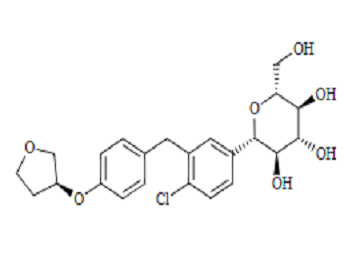English synonyms
Empagliflozin(W.S);Empaglifloin;Empagliflozin API;BI-10773;BI 10773;BI10773;CS-798;EMPAGLIFLBZIN;EMpagliflozin;BI-10773
Properties of Empagliflozin
| Boiling Point | 665℃ |
| Density | 1.398 |
| Flash Point | 356℃ |
| Storage Condition | 2-8°C |
| Solubility | Insoluble in Water; ≥20.75 Mg/Ml in Dmso; ≥7.06 Mg/Ml in Ethanol Solution, Ultrasonic |
| Acidity Coefficient (pKa) | 13.23±0.70(Predicted) |
| Form | Solid |
| Color | White |
| Stability | Hygroscopicity |
Uses and Synthesis of Empagliflozin
Overview
Empagliflozin Is a Sodium-Dependent Glucose Cotransporter 2 (Sglt-2) Inhibitor Developed by Boehringer Ingelheim and Eli Lilly. Sglt-2 Inhibitors Are a New Type of Hypoglycemic Drug That Mainly Inhibits Sglt-2 Expressed in the Kidneys, Reduces Glucose Reabsorption by the Kidneys, Increases Glucose Excretion in the Urine, And Thus Reduces Plasma Glucose Levels. Its Hypoglycemic Effect Is Independent of β-Cell Function and Insulin Resistance.
Application
Empagliflozin Is Used to Improve Blood Sugar Control in Adults with Type 2 Diabetes Who Have Not Achieved Adequate Blood Sugar Control with Diet and Exercise. It Should Not Be Used to Treat Patients with Type 1 Diabetes, Patients with Elevated Ketones in the Blood or Urine (Diabetic Ketoacidosis), Patients with Severe Kidney Damage, End-Stage Kidney Disease, Or Patients on Dialysis.
Pharmacological Action
Under Physiological Conditions, The Kidneys Filter and Reabsorb Glucose into the Circulation System to Maintain Blood Sugar Balance in the Body. Glucose Enters the Blood Through the Renal Tubule Lumen, Which Must Be Coordinated by Glucose Co-Transporters. Sglt2, As a Form of Sodium-Glucose Co-Transporter in Glucose Co-Transporters, Blocks the Reabsorption of Glucose by the Proximal Tubule, Reduces Glucose Reabsorption by the Kidneys, Increases Glucose Excretion in Urine, And Thus Reduces Plasma Glucose Levels. Moreover, This Hypoglycemic Effect Does Not Depend on β-Cell Function and Is Not Affected by Insulin Resistance.
Adverse Reactions
The Incidence of Adverse Reactions in Empagliflozin Is Low. Compared with the Placebo Group, The Incidence of Common Adverse Reactions Is 2%, Including Urinary Tract Infection, Female Reproductive System Fungal Infection, Upper Respiratory Tract Infection, Polyuria, Dyslipidemia (Dose-Related Increase in Low-Density Lipoprotein), Joint Pain, Male Reproductive System Fungal Infection, Hypoglycemia (When Empagliflozin Is Combined with Insulin or Sulfonylurea Hypoglycemic Drugs, The Incidence of Hypoglycemia Increases), And Nausea. Other Adverse Reactions with an Incidence Rate of Less Than 2% Are Common in Thirst (Polydipsia, Polydipsia), Hypovolemia, And Renal Impairment.
Diabetes Medications
Empagliflozin Is a Sodium Glucose Co-Transporter 2 (Sglt2) Inhibitor, Developed Jointly by Boehringer Ingelheim and Eli Lilly Under the Trade Name Jardiance. On August 1, 2014, The U.S. Food and Drug Administration (Fda) Officially Approved Jardiance(Empagliflozin) from Boehringer Ingelheim Pharmaceuticals and Eli Lilly for the Treatment of Type 2 Diabetes to Improve Blood Sugar Control in Adult Patients. Empagliflozin Is the Third Sglt-2 Inhibitor Drug Approved by the Fda. The Other Two Sglt-2 Inhibitor Drugs, Invokana(Canagliflozin) from Johnson & Johnson Pharmaceuticals and Farxiga (Dapagliflozin) from Astrazeneca and Bristol-Myers Squibb, Were Approved by the Fda in November 2013 and January 2014, Respectively. The New Drug Application for Empagliflozin to the Fda Has Been Full of Twists and Turns.In March 2014, The Fda Rejected the New Drug Application for Empagliflozin Submitted by the Boehringer-Eli Lilly Diabetes Alliance Due to a Large Particle Contamination Incident at One of Boehringer;s Empagliflozin Production Plants. In June 2014, The Fda Withdrew the Previously Issued Warning Letter After Fully Reviewing the Materials Submitted by Boehringer Based on the March Inspection Summary and Determining That the Quality Management and Compliance System of the Boehringer Drug Production Plant Was Acceptable. The Boehringer-Eli Lilly Diabetes Alliance Also Resubmitted Its Application to the Fda on June 17.


